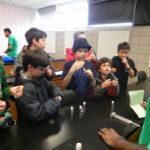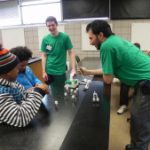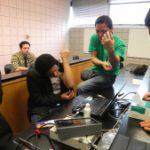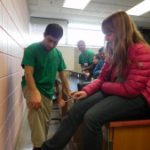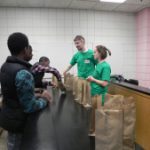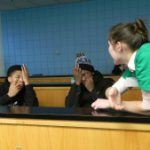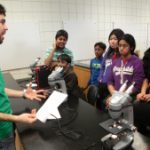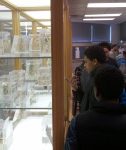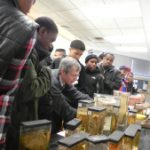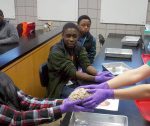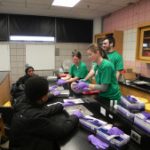This past Spring, members of the NeuroGSA joined forces with the UB Brain Museum to breathe new life into Brain Awareness Week 2013. Traditionally, the NeuroGSA has traveled to local schools, materials in-hand, to deliver interactive learning demonstrations to students within their own classrooms. This year, with the collaboration of Brain Museum curator Dr. Christopher Cohan and the Center for Urban Studies coordinator Gavin Luter, the NeuroGSA was able to invite schools to take field trips to UB’s South Campus. This change in venue allowed for the NeuroGSA to connect students to the Brain Museum and the anatomy laboratories of the Biomedical Education Building, while expanding their resources for scientific investigation.
Fourteen UB graduate students demonstrated various topics of neuroscience including anatomy, cellular biology, attention and perception, reflexes and nerves, and sensory systems. Anatomy was explored using fixed human brains and cow eyes; cells were visualized by microscopy of brain and tongue sections from mouse and monkey; attention and perception were explained with video and props; nerves were investigated with reflex hammers and an electrical stimulator; auditory sensation was examined with tuning forks; olfactory and tactile sensation were tested by identification of mysterious scents and textured items. Finally, visiting students also spent time in the Brain Museum where Dr. Cohan led a discussion about brain disease and the specimen on display.
The schools which participated in Brain Awareness Week were Futures Academy High School from downtown Buffalo and Heim Middle School from Williamsville. The NeuroGSA members who volunteered were: Tom Covey, Lara Duffney, John Fleites, Jay Garaycochea, Sushmitha Gururaj, Mateen Haroon, Tad Kaczynski, Nived Nair, Naomi McKay, Claire Modica, Tenzin Ngodup, Kim Plyler, Tony Sacca, and Philip Whalen. The fixed brain and eyes, brain and tongue sections, microscopes, reflex hammers, and tuning forks were provided by Dr. Cohan and the Brain Museum. The electrical stimulator was provided by the Biological Sciences Department. The video and visual props for attention and perception, as well as the collection of items to identify by touch and smell, were gathered and prepared by members of the NeuroGSA. Name tags for the NeuroGSA and visiting students were provided by Dr. Ray Dannenhoffer. Uniform t-shirts, designed by the NeuroGSA, were provided by Dr. Malcolm Slaughter and the Neuroscience Program.
In the months since March, Brain Awareness Week has elongated into a year-round relationship between the NeuroGSA and the Brain Museum. Neuroscience graduate students have continued to participate in field trips other schools have scheduled to the Brain Museum, thereby expanding NeuroGSA’s ongoing community service and investment in local educational enrichment.
If you would like to volunteer with the NeuroGSA, or you know of a class which would like to learn about neuroscience, please email buffalo.ngsa@gmail.com with your inquiry.

